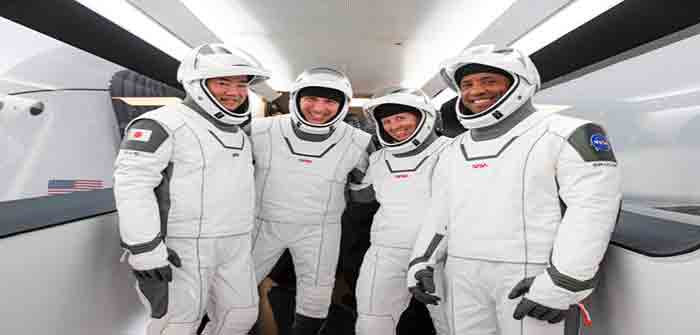
What seemed impossible not long ago is now on the verge of becoming routine. A SpaceX Crew Dragon capsule successfully launched into orbit on Sunday night from NASA’s Kennedy Space Center in Florida, setting four astronauts on a course for the International Space Station (ISS). It’s the second crewed launch for SpaceX this year.
By Monday night, the four astronauts will rendezvous and dock with ISS. They’ll spend the next six months carrying out scientific experiments alongside fellow astronauts and cosmonauts who are already on board, bringing the total number of crew members on the space station to seven.
This particular Crew Dragon capsule mission is named Resilience, a nod to the extreme difficulties that were overcome to make this historic launch happen, including this year’s COVID-19 pandemic.
“The message that [the crew] wanted to convey is resilience,” NASA’s ISS program manager Joel Montalbano said at a briefing on Friday. “It was a hard journey to get here.”
It wasn’t just COVID, either. For NASA and SpaceX, the difficult journey to Sunday’s launch has stretched out over nearly a decade. When NASA formally retired the Space Shuttle Program in 2011, the federal government decided they’d focus their efforts on getting astronauts to the Moon and Mars, while paying private companies to ferry people and cargo to the space station.
NASA imagined the first Commercial Crew Program flight would happen in 2016. But SpaceX and Boeing, the companies hired for the job, were hit by a seemingly unending series of delays. In the meantime, American taxpayers were left paying for tickets on Russia’s Soyuz rockets in order to get NASA astronauts to the largely U.S.-funded space station.

Earlier this year, during the Demo-2 mission, SpaceX Crew Dragon Endeavor spacecraft was pulled from the Gulf of Mexico by SpaceX’s GO Navigator recovery ship. It was then nestled into the “Dragon nest”. (Credit: NASA/Bill Ingalls)
However, over the past two years, SpaceX has slowly overcome its early challenges. The company is now the only contractor to successfully ferry astronauts. In May, SpaceX’s Crew Dragon spacecraft successfully carried two NASA astronauts to the ISS on a demonstration mission, called Demo-2. That trip was the first time astronauts had traveled into orbit on a private spacecraft. Elon Musk’s rocket company also launched an empty Crew Dragon capsule to the space station on a fully robotic test flight in March 2019…
Continue Reading